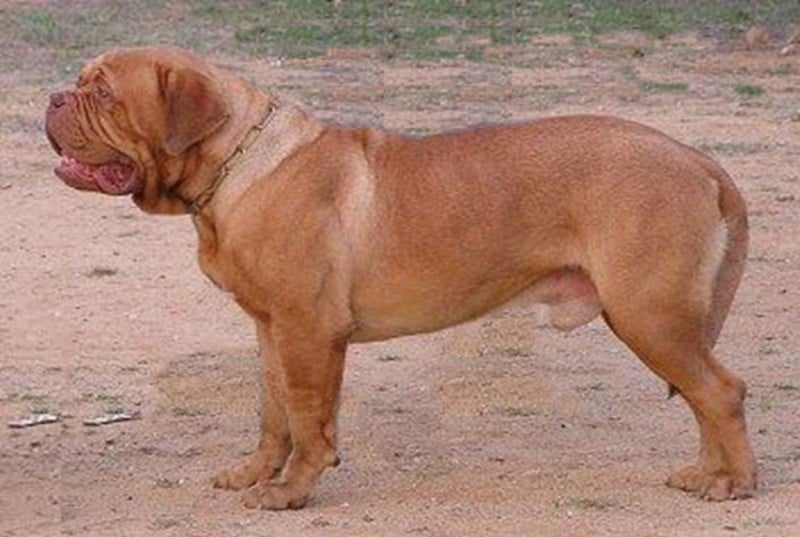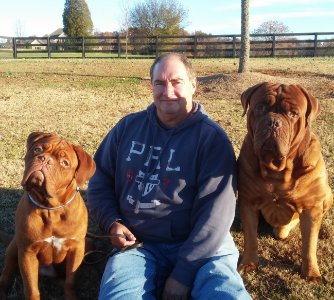The Dogue de Bordeaux is a breed with a “concave outline” and has the most “bulldog features” among the mastiff breeds. French Professor Raymond Triquet, who resurrected the Dogue de Bordeaux from near-extinction and is responsible for developing and writing the FCI Breed Standard, refers to the breed as having a “concave-lined” profile.
In his Saga of the Dogue de Bordeaux, Triquet states, “The concave characteristics of the breed include having extremities (tail and feet) that are thick, heavy bone, slight upward tilt of the muzzle, slightly toes out in the front, skin is thick, and there is a slight dip in the topline.”
Triquet further states, “It is the nature of the Dogue de Bordeaux to be concave, it cannot be otherwise.” Stated another way, the breed’s phenotype demands that the breed have concave features.
The AKC Breed Standard covers these concave features throughout the document as the following examples show: “When viewed in profile, the foreface is very slightly concave, nose slightly upturned is permissible, the lower jaw curves upward, tail is very thick at the base, forearms, when viewed from the front, are straight or inclining slightly inwards, pasterns, when viewed from the front, may bend slightly outwards.”
The AKC Breed Standard further states, “Hindquarters—Powerful legs with strong bone structure; well angulated, skin-thick and sufficiently loose fitting.” Referencing the Dogue de Bordeaux’s topline, the Breed Standard states, “…solid, with a broad and muscular back.”
Note that the AKC Breed Standard does not state that the topline is level. As Triquet emphasizes, “It is against the Dogue de Bordeaux’s nature to have a level topline.”
Professor Triquet provides additional views on what a correct topline should be for the breed by stating, “Let’s be clear that we don’t say ‘straight’ and even less, ‘rectilinear.’ No molossus has a rectilinear topline. In the Dogue de Bordeaux, we aim for it to be as straight as possible in a concave-lined dog. The top line always has a slight, or very slight dip.”
When describing the rib cage of the breed, Triquet makes additional reference to the topline’s structure as contributing to the breed’s function and flexibility in the following statement: “In the Dogue de Bordeaux, the rib cage is high (deep) and hangs relatively low (but not as low as in the Bulldog). That permits him to lower the whole body when anticipating an attack or running at an active and prolonged trot: the chest drops slightly, and the back has a tendency to dip.”
Among the questions asked of our mentors at ringside mentoring sessions or our Judges’ Education Seminars is why the Dogue de Bordeaux has these concave features in the first place. The answer is that these characteristics are due to the Bulldog influence in the Dogue de Bordeaux’s ancestral history, and that form followed the breed’s function as a guardian, gladiator, and hunter. However, as far as which bulldogs contributed to the Dogue de Bordeaux’s evolution, there are varying theories on that subject.
Some hypothesize that “large-framed” Spanish Bulldogs from the Iberian Peninsula contributed the “bulldog influence” to the breed, while others theorize that it was the bulldogs brought to France by the British during England’s presence in that country. It may have been a combination of one or several scenarios, but in any case, the bulldog contribution to the Dogue de Bordeaux is readily apparent.
Catherine Marien-de Luca of The Bulldog Information Library provides insight into the features of the Spanish Bulldog that may have contributed to the makeup of the Dogue de Bordeaux. In her description of the Spanish Bulldog, Marien-de Luca states, “This dog was taller than the present-day Bulldog (60-65 cm) with a weight of around 50 kg. He had a massive rounded head with a short muzzle and was flat faced.”
In summary, the phenotype of the Dogue de Bordeaux is to be a concave-lined breed whose very existence is a direct result of the evolution and functional role that the breed has represented throughout its history. The breed’s athleticism, movement, function, and status as a working breed are facilitated in no small part by the various concave features that form the breed’s makeup. As Triquet points out, “It is against his nature to be otherwise.”
Are you looking for a Dogue de Bordeaux puppy?
The best way to ensure a long and happy relationship with a purebred dog is to purchase one from a responsible breeder. Not sure where to begin finding a breeder? Contact the National Parent Club’s Breeder Referral person, which you can find on the AKC Breeder Referral Contacts page.
Want to help rescue and re-home a Dogue de Bordeaux dog?
Did you know nearly every recognized AKC purebred has a dedicated rescue group? Find your new best friend on the AKC Rescue Network Listing.
Dogue de Bordeaux Dog Breed Magazine
Showsight Magazine is the only publication to offer dedicated Digital Breed Magazines for ALL recognized AKC Breeds.
Read and learn more about the athletic Dogue de Bordeaux dog breed with articles and information in our Dogue de Bordeaux Dog Breed Magazine.
Error embedding FlippingBook shortcode, please check the flipbook url. (https://digital.showsightmagazine.com/view/501689/)









